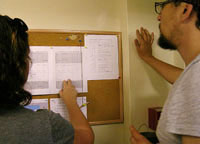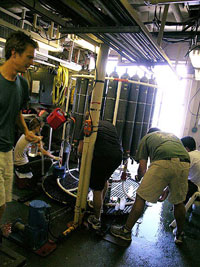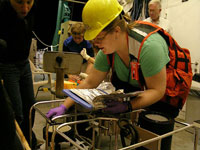- C-MORE Home
- What is Microbial Oceanography?
- What is C-MORE?
- Research
- • Research Cruises
- » BioLINCS
- Home
- Cruise Participants
- Instruments Used
on the Cruise - Nitrogen Cycling
- Marine Microbes
- Cruise Blog
- Data Archive
- Education & Outreach
- People
- Publications
- Image Library
- Contact Us
| |||||||||||||||||||||||||||||||||||
BioLINCS Cruise Blog
Tuesday, September 13, 2011
|
Kendra Turk-Kubo and Deniz Bombar discuss the schedule that specifies when each instrument, including the CTD array, will be deployed and recovered. This schedule regulates the lives of almost everyone on board the Kilo Moana. Since we left port seven days ago, it has been revised 14 times. |
|
Researchers gather in a sampling frenzy around the array of gray “Niskin Bottles” after a CTD cast. Some groups have entire bottles allotted to them. Others take little samples from each bottle. It’s a scene that seems chaotic, but is actually quite organized. |
|
Ben Rubin stands by to help deploy the “McLane pump” off the back deck of the Kilo Moana. This pump is lowered down into the depths, where it filters hundreds of liters each hour automatically. |
|
Tara Clemente looks on as Sara Lincoln removes a filter from one of two McLane pumps that she deployed this afternoon (but recovered this evening). The filter started out white in color, but has taken on a rich yellow-tan hue due to pigments in all the microbes that have collected on its surface. |
Yesterday we conducted five CTD casts in one day— a record for this cruise. There were casts at roughly 02:00, 07:00, 13:00, 15:00 and 17:00, each lasting an hour more. I asked Tara Clemente, who has been on a lot of cruises, why the researchers, some of whom are already putting 20-hour days, would want yet more samples to process. She explained that everyone is just trying to make the best use of their time at sea.
Ship time costs tens of thousands of dollars a day, and for many researchers this may be their only opportunity to collect samples this year. So they try to collect as many samples and perform as many experiments as they possibly can. This makes even more sense when you consider that they will be analyzing their samples and working on the data from this cruise for months or years after the cruise. As one researcher put it, “I can sleep when the cruise is over.”
This morning we “recovered” (brought back on board the ship) the Incubating Productivity Systems (IPS) and the Submersible Incubation Device (SID), which have been drifting around since last Thursday. Fortunately, they and the Lagrangian sediment traps have been drifting in more or less the same direction and speed as the Environmental Sample Processor (ESP), which we are following with the ship. This fact, along with the comfortable sea conditions, has made it much easier to follow through with the ambitious goals of this cruise.
The other important element in our success so far has been the impressive work of the marine technicians and crew of the Kilo Moana. They have handled every instrument deployment and recovery efficiently and safely, despite the complicated arrays of instruments we have thrown at them. And we have deployed a lot of instruments. Between CTD casts, deployments, and recoveries, it’s rare that the back deck of the ship is unoccupied for more than an hour or two, even in the middle of the night. We are indeed making the most of our time at sea.
Considering that we brought about 1,440 liters (380 gallons) of seawater up from the depths yesterday, it’s amazing that the ship isn’t awash in the stuff. It turns out that much of this seawater is passed through filters to extract the microbes. The filters are then processed on the ship or preserved for later analysis on shore. In many cases, this processing has to be done quickly, before the microbes die or various chemical compounds break down. Especially for microbes that are fairly rare, you need to filter a lot of seawater (dozens of liters) to get enough genetic material to work with.
Sara Lincoln of MIT has been deploying a seawater-sampling device which addresses this problem in a unique way. It allows researchers to send the filter down to the seawater instead of bringing the seawater up to the filter. Basically it consists of a high-volume submersible, programmable pump, which is lowered into the ocean and spends several hours at a specific depth, pumping seawater through a two different filters. At the end of the deployment, the pump and filters are brought back to the surface. The “McLane pump,” as it’s called, runs on a timer, but will slow down if a filter starts to get clogged.
During a four-hour deployment, the single McLane pump can filter about 1,800 liters of water—more than we collected during all of yesterday’s CTD casts combined. The only hitch is that we can’t deploy any other instruments off the back deck while the McLane pumps are on the water. So these pumps are often deployed in the wee hours of the morning. Being “babysitter” for the McClain pumps is one reason that Sara hasn’t been getting much sleep over the last few days.
When the cruise is over, Sara will take the large (140 mm) filters from the pump back to her lab at MIT. She will cut out sections of the filters for DNA or RNA analysis (for example, to figure out what kind of microbes they captured). She will also be analyzing the contents of the fine filters for organic compounds (lipids) produced in the cell walls of archaea. Archaea are an ancient lineage of microbes that look similar to bacteria, but are in a completely different biological domain. They are one of the most important microbes in nitrogen cycling, particularly the process of converting ammonium to nitrate (nitrification).
Some of the compounds from the cell walls of archaea are so durable that they can be found in the fossilized chemical remains of archaea that are over 100 million years old. Sara will analyze the compounds collected on her filters and compare these with similar compounds from fossilized archaea. This will help researchers understand more about the relationships between ancient and modern archaea.
There is some evidence that archaea have been around for billions of years, beginning at a time when the Earth’s atmosphere did not yet contain any oxygen (because photosynthesis had not yet evolved). These days, archaea can be found in both fresh and salt water, but also in some of the hottest, coldest, and saltiest environments on Earth. Places where no other organisms can exist. It will be interesting to see how archaea adapt to all the changes that humans are causing to the Earth’s atmosphere and oceans. I am not a betting man. But one thing I would bet on—one way or another, the archaea will survive.
[ Top of Page ]







